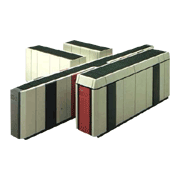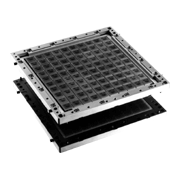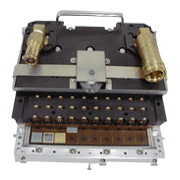In April 1984, NEC announced the SX-3 Series of supercomputers, which were the fastest in the world at that time. The SX-3 Series employed state-of-the-art technology, such as ultra-LSI with 20,000 gates per chip and a delay time per gate of 70 picoseconds, and was the first Japanese-made machine to achieve a loosely coupled multiprocessor system in which up to a maximum of 4 arithmetic processors shared main memory. In this way, the system achieved the world's highest processing speed with a maximum vector operation performance of 1.37 gigaFLOPS (max.) with a single processor, and 22 gigaFLOPS (max.) with a multiprocessor.
The Series used ultra high-speed CML LSI, with 20,000 gates per chip and a delay time per gate of 70 picoseconds, and high-speed RAM which achieved single-chip integration of a 7,000-gate logic circuit and a memory circuit with a capacity of 40 kilobits and access time of 1.6 nanoseconds.
NEC developed a new LSI ultra high-density package enabling mounting of a maximum of 100 ultra high-speed LSI on a multi-layer wiring board employing a polyimide-based resin insulation coating (suitable for high-speed operation) and thin-film microwiring technology. This made it possible to achieve ultra high-density mounting with a maximum of 2 million gates per package.
| Model 11 |
Model 12 |
Model 14 |
Model 22 |
Model 24 |
Model 42 |
Model 44 |
|
|---|---|---|---|---|---|---|---|
| Announcement date | April 1989 | ||||||
| Max vector operation performance (GFLOPS) |
1.37 | 2.75 | 5.5 | 11 | 22 | ||
| Number of arithmetic processors | 1 | 2 | 4 | ||||
| Vector operation pipelines | 4 | 8 | 16 | 8 | 16 | 8 | 16 |
| Scalar operation pipelines | 1set | ||||||
| Max. main memory capacity | 512MB | 1GB | 2GB | ||||
| Number of channels | Max. 256 | ||||||
| Max. overall data transfer speed | 1GB/s | ||||||




